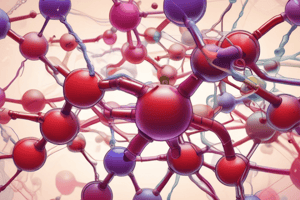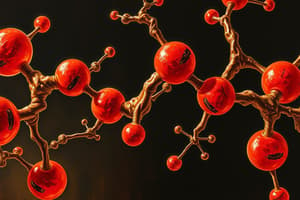Podcast
Questions and Answers
What is the function of myoglobin in muscle tissue?
What is the function of myoglobin in muscle tissue?
- To transport oxygen from the lungs to the muscles
- To produce energy for muscle contractions
- To act as an oxygen reservoir during muscle contractions (correct)
- To regulate muscle relaxations
What is the site of oxygen binding in myoglobin?
What is the site of oxygen binding in myoglobin?
- The heme group (correct)
- The mitochondria
- The polypeptide chain
- The muscle fibers
How many oxygen molecules can bind to one myoglobin molecule?
How many oxygen molecules can bind to one myoglobin molecule?
- Two
- Four
- One (correct)
- Eight
What is a clinical significance of elevated myoglobin levels in the blood?
What is a clinical significance of elevated myoglobin levels in the blood?
What is the key difference between myoglobin and hemoglobin?
What is the key difference between myoglobin and hemoglobin?
What is the significance of myoglobin in high-intensity, short-duration activities?
What is the significance of myoglobin in high-intensity, short-duration activities?
Flashcards are hidden until you start studying
Study Notes
Myoglobin Structure and Function
- Myoglobin is a globular protein found in muscle tissue
- It stores oxygen for muscle contractions
- Composed of a polypeptide chain (153 amino acids) and a heme group
- Heme group contains iron, which binds to oxygen
Oxygen Binding
- Myoglobin has a high affinity for oxygen (pO2)
- Oxygen binds to the iron atom in the heme group
- Binding is reversible, allowing for release of oxygen when needed
- Myoglobin can hold one oxygen molecule per molecule
Function in Muscle Tissue
- Myoglobin acts as an oxygen reservoir during muscle contractions
- Provides oxygen to mitochondria for energy production
- Helps to facilitate rapid muscle contraction and relaxation
- Especially important in high-intensity, short-duration activities (e.g. sprinting)
Differences from Hemoglobin
- Myoglobin has a higher affinity for oxygen than hemoglobin
- Myoglobin is found in muscle tissue, whereas hemoglobin is found in red blood cells
- Myoglobin binds to one oxygen molecule, whereas hemoglobin binds to four
Clinical Significance
- Elevated myoglobin levels in the blood can indicate muscle damage or injury
- Myoglobinuria (myoglobin in the urine) can be a sign of rhabdomyolysis, a serious muscle disorder
Myoglobin Structure
- Globular protein found in muscle tissue, composed of a polypeptide chain (153 amino acids) and a heme group
- Heme group contains iron, which binds to oxygen
Oxygen Binding and Function
- High affinity for oxygen (pO2)
- Oxygen binds to the iron atom in the heme group, binding is reversible
- Myoglobin can hold one oxygen molecule per molecule
- Acts as an oxygen reservoir during muscle contractions, providing oxygen to mitochondria for energy production
- Facilitates rapid muscle contraction and relaxation, especially important in high-intensity, short-duration activities (e.g. sprinting)
Comparison with Hemoglobin
- Higher affinity for oxygen than hemoglobin
- Found in muscle tissue, whereas hemoglobin is found in red blood cells
- Binds to one oxygen molecule, whereas hemoglobin binds to four
Clinical Significance
- Elevated levels in the blood can indicate muscle damage or injury
- Myoglobinuria (myoglobin in the urine) can be a sign of rhabdomyolysis, a serious muscle disorder
Studying That Suits You
Use AI to generate personalized quizzes and flashcards to suit your learning preferences.




